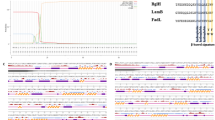Abstract
Treatment of Helicobacter pylori cells with several chaotropic agents resulted in different degrees of inhibition in the binding of the bacteria to hemin and Congo-red dye. Polyanions also yielded a >50% inhibitory effect. Furthermore, hydrophobic interaction chromatography was used to determine the relative surface hydrophobicity of cell-associated proteins extracted with 3 mol/L urea, revealing proteins with a significant hydrophobic profile.


Similar content being viewed by others
Abbreviations
- CR:
-
Congo-red
- HIC:
-
Hydrophobic interaction chromatography
- HM:
-
Hemin
- H.p. :
-
Helicobacter pylori
- HS:
-
Heparan sulfate
- PBS:
-
Phosphate-buffered saline
- PEG:
-
Poly(ethylene)glycol
- SDS-PAGE:
-
Sodium dodecyl sulfate polyacrylamide gel electrophoresis
References
Ascencio F, Fransson LA, Wadström T (1993) Affinity of the gastric pathogen Helicobacter pylori for the N-sulfated glycosaminoglican heparan sulfate. J Med Microbiol 38:240–244
Braun PC (2005) The effect of farnesol on amino acid incorporation by a wild-type and cell-wall variant strain of Candida albicans. Can J Microbiol 51:715–718
Caughey B, Brown K, Raymond GJ, Katzenstein GE, Thresher W (1994) Binding of the protease-sensitive form of prion protein PrP to sulfated glycosaminoglycan and Congo-red. J Virol 68:2135–2141
Dillon JK, Fuerst JA, Hayward AC, Davis GHG (1986) A comparison of five methods for assaying bacterial hydrophobicity. J Microbiol Meth 6:13–19
Dubois A, Boren T (2007) Helicobacter pylori is invasive and it may be a facultative intracellular organism. Cell Microbiol 9:1108–1116
Geis G, Leying H, Suerbaum S, Opferkuch W (1990) Unusual fatty acid substitution in lipids and lipopolysaccharides of Helicobacter pylori. J Clin Microbiol 28:930–932
Hirmo S, Utt M, Ringner M, Wadström T (1995) Inhibition of heparan sulfate and other glycosaminoglycans binding to Helicobacter pylori by various polysulfated carbohydrates. FEMS Immunol Med Microbiol 10:301–306
Krediet CJ, Ritchie KB, Cohen M, Lipp EK, Sutherland KP, Teplitski M (2009) Utilization of mucus from the coral Acropora palmata by the pathogen Serratia marcescens and by environmental and coral commensal bacteria. Appl Environ Microbiol 75:3851–3858
Laemmli UK (1970) Cleavage of structural proteins during the assembly of the head of bacteriophage T4. Nature 227:680–685
Matz C, Jürgens K (2001) Effects of hydrophobic and electrostatic cell surface properties of bacteria on feeding rates of heterotrophic nanoflagellates. Appl Enfiron Microbiol 67:814–820
Pruul H, Goodwin CS, McDonald PJ, Lewis G, Pankhurst D (1990) Hydrophobic characterization of Helicobacter (Campylobacter) pylori. J Med Microbiol 32:93–100
Qadri F, Hossain SA, Ciznar I, Haider K, Ljungh A, Wadström T, Sack DA (1988) Congo-red binding and salt aggregation as indicators of virulence in Shigella species. J Clin Microbiol 26:1343–1348
Rosenberg M, Kjelleberg S (1986) Hydrophobic interactions: role in bacterial adhesion. Adv Microb Ecol vol 9, 1st edn. Plenum Publishing Corp, Heidelberg
Ruiz-Bustos E, Ochoa JL, Wadström T, Ascencio F (2001) Isolation and characterization of putative adhesins from Helicobacter pylori with affinity to heparin sulfate proteoglycan. J Med Microbiol 50:215–222
Tashima KT, Carroll PA, Rogers MB, Calderwood SB (1996) Relative importance of three iron-regulated outer membrane proteins for in vivo growth of Vibrio cholerae. Infect Immun 64:1756–1761
Wadström T (1990) Hydrophobic characteristics of staphylococci: role of surface structures and role in adhesion and host colonization, pp. 315–333 In: RJ Doyle, M Rosenberg (eds) Microbial Cell Surface Hydrophobicity. American Society of Microbiology
Walter H, Johansson G (1986) Partitioning in aqueous two-phase systems: an overview. Anal Biochem 155:215–242
Wilson MK, Abergel RJ, Arceneaux JE, Raymond KN, Byers BR (2010) Temporal production of the two Bacillus anthracis siderophores, petrobactin and bacillibactin. Biometals 23:129–134
This work was supported by the Center for Biological Research, CIBNOR (ABM-11). The first author was recipient of a scholarship (59291) from the Mexican Council of Science and Technology (CONACyT). We thank Tec. A.A. Cruz for assistance on chromatographic procedures.
Author information
Authors and Affiliations
Corresponding author
Rights and permissions
About this article
Cite this article
Ruiz-Bustos, E., Wadström, T. & Ascencio, F. Participation of cell-surface hydrophobins for hemin binding in Helicobacter pylori . Folia Microbiol 56, 241–245 (2011). https://doi.org/10.1007/s12223-011-0043-z
Received:
Accepted:
Published:
Issue Date:
DOI: https://doi.org/10.1007/s12223-011-0043-z




